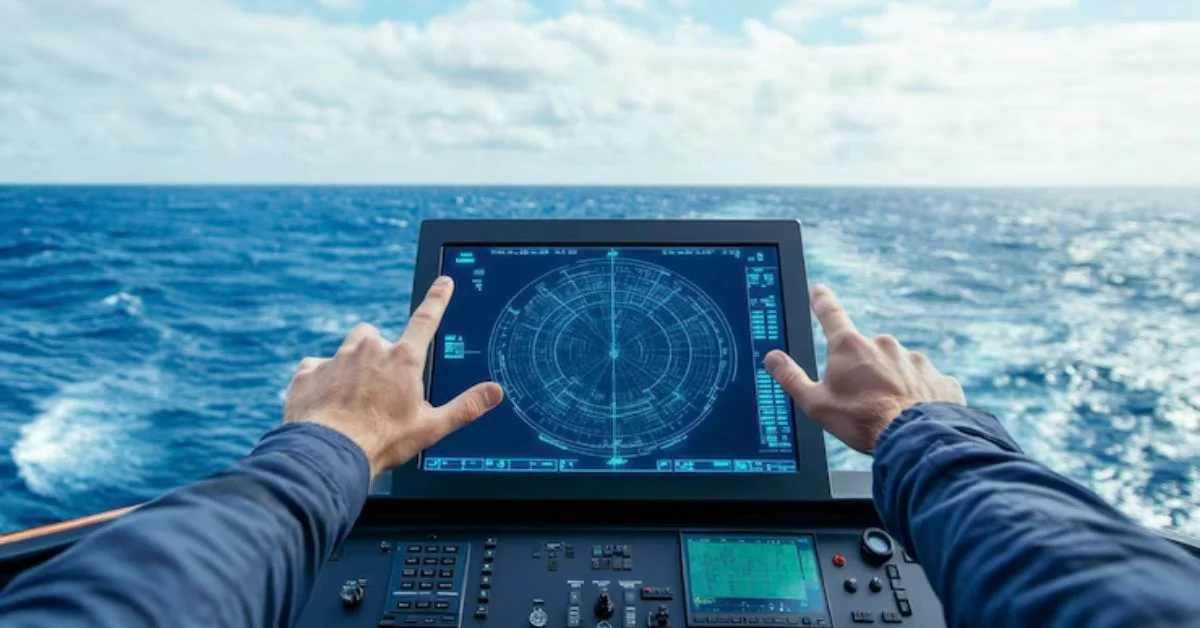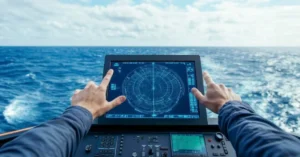Ocean electronic refers to all electronics specifically engineered for use in marine environments—encompassing sonar, underwater sensors, navigation systems, communication networks, and oceanographic instrumentation.
In the overview that follows, we’ll chart its history, explain key technologies, explore real-world applications (from shipping to research to defense), examine design challenges, and anticipate future trends—helping you grasp why ocean electronics matter now more than ever.
1. A Brief History of Ocean Electronics
1.1 Early Navigation and Foghorns
The maritime journey began with simple mechanical aids—sextants, compasses, and foghorns. As radio emerged in the early 20th century, ships gained wireless navigation and distress communication capabilities.
1.2 Wartime Innovation
World War II accelerated tech advances—sonar (ASDIC) detected submarines, and nav systems evolved. Electronics became integral to naval strategy and safety.
1.3 Rise of Research Electronics
By the 1960s and ’70s, oceanographers adopted electronic sensors to monitor temperature, salinity, and currents. These formed the foundation of oceanographic instrumentation and climate science.
1.4 Digital Electronics and Autonomy
The 21st century ushered in GPS, broadband communications, autonomous systems, and IoT-connected sensors—transforming ocean electronics into intelligent, networked systems.
2. Core Ocean Electronic Technologies
2.1 Sonar and Acoustic Systems
- Echo Sounders: Measure depth—essential for bathymetry and navigation.
- Side-Scan Sonar: Renders detailed seabed images—crucial for archaeology and pipeline inspection.
- Multibeam Sonar: Maps wide swaths of the ocean floor simultaneously.
- Acoustic Doppler Current Profilers (ADCPs): Measure underwater current velocity.
2.2 Navigation and Positioning
- GPS & Differential GPS: Offer pinpoint location on the surface.
- Inertial Navigation: Supports ships and subs when GPS falters.
- Underwater Acoustic Positioning: Localizes submersibles and sensors beneath waves.
2.3 Underwater Sensors
- CTD Units: Measure Conductivity, Temperature, Depth—critical for climate models.
- Dissolved Oxygen Probes: Air quality in seas, algae predictions, ecosystem health.
- pH Sensors: Track ocean acidification.
- Acoustic Telemetry: Communicates data via underwater modems.
2.4 Communication Systems
- HF & Satellite Radio: Maintain ship-to-shore contact.
- Underwater Acoustic Modems: Allow data exchange between submerged platforms.
- Buoy-Based Relays: Surface units that bridge deep-sea sensors to satellites.
2.5 Autonomous Platforms
- AUVs (Autonomous Underwater Vehicles): Carry sensors for mapping, inspection, or biological sampling.
- Gliders: Energy-efficient vehicles that drift using buoyancy and currents.
- Unmanned Surface Vessels: Collect meteorological and wave data.
3. Key Applications in Marine Electronics
3.1 Shipping and Navigation
Modern vessels use integrated electronic bridges—tidal charts, collision-avoidance radar, GPS, and depth sounders—ensuring safer voyages and route optimization.
3.2 Resource Extraction and Energy
Oil rigs and windfarms rely on seabed mapping, pipeline monitoring, and structural inspections—often using AUVs, multibeam sonar, and submersible electronics.
3.3 Scientific Research
Oceanographers deploy sensor arrays measuring temperature, salinity, pH, oxygen—feeding data to climate models, fisheries management, and environment monitoring.
3.4 Environmental Monitoring
Marine electronics: tsunami buoys, oil-spill sensors, coral reef monitors. Early warnings and assessments protect communities and ecosystems.
3.5 Defense and Security
Navies use sonar arrays, towed arrays, underwater acoustic networks, and unmanned platforms for surveillance, mine countermeasures, and submarine detection.
4. Design Challenges Unique to Ocean Environments
4.1 Pressure and Depth
Every 10 m adds one atmosphere of pressure. Electronics must be pressure-hardened or housed in pressure-tolerant cases.
4.2 Corrosion
Saltwater corrodes metal—electronics must use special alloys, protective coatings, and sealed enclosures.
4.3 Biofouling
Marine growth impairs sensors and hulls. Anti-fouling surfaces, periodic cleaning, and self-cleaning mechanisms are essential.
4.4 Power and Energy
Remoteness means power must be self-contained. Many devices use long-life batteries, solar, wave, or turbine energy harvesting.
4.5 Communication Constraints
Water severely degrades radio waves. Acoustics are slow and distorted, and optical systems lack range—requiring careful design and redundancy.
4.6 Longevity and Reliability
These systems often operate for months without human access—durability and remote diagnostics are vital design considerations.
5. Innovations Shaping the Future of Ocean Electronics
5.1 Internet of Underwater Things (IoUT)
Networks of acoustic modems and communication relays create intelligent, interconnected sensor webs.
5.2 Energy Harvesting
Devices that recharge from waves, thermal gradients, or micro-hydrokinetic generators reduce the need for servicing.
5.3 AI-Enabled Platforms
Autonomous vehicles use machine learning for:
- Self-navigation
- Object detection and classification
- Adaptive survey strategies
5.4 Miniaturization and Cost Reduction
Tiny sensors for widespread deployment, including nanosensors for toxin detection and tiny AUVs for fish tracking.
5.5 Citizen Science Tools
Affordable sensors, DIY autonomy kits, and open-source electronics allow coastal communities to gather their own marine data.
6. Economic Landscape and Industry Players
Ocean electronics field spans:
- Global marine tech corporations producing shipborne radar and sonar.
- Defense contractors developing subsea warfare systems.
- Oceanographic device firms manufacturing CTD probes and AUVs.
- Startups crafting mini-AUVs, IoUT electronics, and energy-harvesting sensors.
- Academic labs prototyping field electronics—translating research to industrial solutions.
Market growth is driven by climate research funding, offshore energy, maritime safety regulation, and defense spending.
7. Case Studies in Ocean Electronic Success
7.1 Bathymetric Mapping for Shipping Safety
A port authority deployed multibeam sonar to chart shifting seabeds—leading to safer routes and reduced dredging costs.
7.2 Gliders Monitoring Ocean Heat Content
University teams dispatched gliders to track temperature changes—feeding climate models and fisheries predictions for years.
7.3 AUV Surveys of Offshore Wind Foundations
An autonomous robot periodically inspects sea floor debris and corrosion at turbine bases—reducing service expenses and improving safety.
7.4 Coastal Water-Quality Buoy Network
An IoUT network reports in real time on algae blooms, oxygen drops, and runoff—allowing proactive public alerts.
8. What the Future Holds
8.1 Miniature Swarm Robotics
Fleets of micro-drones working together to map and monitor areas in parallel.
8.2 Data Integration Platforms
Real-time 3D models of marine environments combining satellite, sonar, sensor, and AUV data.
8.3 Sustainable, Bio-Inspired Devices
Sensors and vehicles built from recyclable materials or biodegradable polymers to address marine pollution.
8.4 AI-Powered Predictive Analytics
Early-warning systems for tsunami threats, fish-stock collapse, or hypoxic events—powered by ocean electronic data AI.
8.5 Global Collaborations
Shared global sensor networks, open standards, and crowdsourced data providing insights for climate action, shipping, conservation, and disaster readiness.
9. Ethics and Environmental Responsibility
9.1 Marine Wildlife Protection
Sonar and AUVs must minimize harm to ecosystems—regulating frequency and intensity, using passive listening, and avoiding sensitive areas.
9.2 Data Privacy and Sovereignty
Some countries limit marine data collection within maritime zones. Responsible deployment considers geopolitical and legal frameworks.
9.3 Ocean Debris Management
Devices must be securely tracked or biodegradable to prevent ocean litter.
Conclusion
Ocean electronic is far more than a term—it’s the lifeline that connects human curiosity, commerce, and conservation with the vast marine world. From safety systems guiding ships to sensor nets monitoring heating seas, this field is essential to unlocking oceanic insight and stewardship.
As technology matures, power harvesting, AI independence, and miniaturization promise smarter, greener marine systems. With thoughtful design and ethical deployment, ocean electronics will continue to be our eyes and ears beneath the waves—helping us understand, protect, and sustainably harness the seafloor and the surface.
FAQs
1. What counts as ocean electronic equipment?
Includes any electronic device designed for marine environments—sonar, underwater sensors, navigation systems, AUVs, buoys, and communication modems.
2. How do underwater sensors communicate?
They use acoustic modems, Buoy relays to satellite, or lift themselves above the surface to transmit via radio frequencies.
3. Aren’t electronics damaged by salt water?
Marine electronics are built with sealed housings, corrosion-resistant coatings, and pressure-rated enclosures to survive underwater exposure.
4. What powers ocean sensors remotely?
Battery packs with high energy density, plus renewable sources like solar panels, wave energy generators, and thermal difference harvesters.
5. Can citizens afford ocean electronics?
Low-cost sensors, open-source hardware, and DIY AUV kits allow citizen science—but quality and durability may lag behind commercial-grade options.
For more information, click here.









